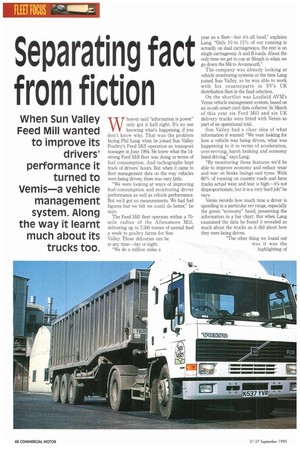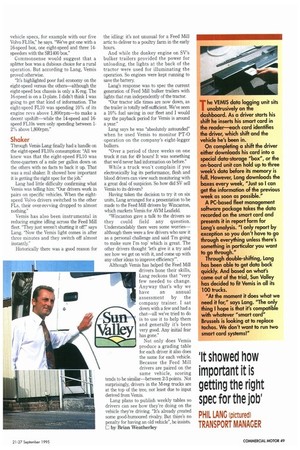Separating fact from fiction
Page 50

Page 51

If you've noticed an error in this article please click here to report it so we can fix it.
When Sun Valley Feed Mill wanted to improve its drivers' performance it turned to Vemis—a vehicle management system. Along the way it learnt much about its trucks too.
hoever said "information is power" only got it half right. It's no use knowing what's happening, if you don't know why. That was the problem facing Phil Lang when he joined Sun Valley Poultry's Feed Mill operation as transport manager in June 1994. He knew what the 14strong Feed Mill fleet was doing in terms of fuel consumption. And tachographs kept track of drivers' hours. But when it came to fleet management data on the way vehicles were being driven, there was very little.
"We were looking at ways of improving fuel consumption and monitoring driver performance as well as vehicle performance. But we'd got no measurements We had fuel figures but we felt we could do better," he says.
The Feed Mill fleet operates within a 70mile radius of the Allensmore Mill, delivering up to 7,500 tonnes of animal feed a week to poultry farms for Sun Valley. Those deliveries can be at any time—day or night.
"We do a million miles a year as a fleet—but it's all local," explains Lang. "Only 10 to 15% of our running is actually on dual carriageways, the rest is on single carriageway A and B roads. About the only time we get to run at 56mph is when we go down the M4 to Avonmouth."
The company was already looking at vehicle monitoring systems at the time Lang joined Sun Valley, so he was able to work with his counterparts in SV's UK distribution fleet in the final selection.
On the shortlist was Leafield AVM's Vemis vehicle management system, based on an in-cab smart card data collector. In March of this year six Feed Mill and six UK delivery trucks were fitted with Vemis as part of an operational trial.
Sun Valley had a clear idea of what information it wanted: "We were looking for how a vehicle was being driven, what was happening to it in terms of acceleration, over-revving, harsh braking and economy band driving," says Lang.
"By monitoring those features we'd be able to improve economy and reduce wear and tear on brake linings and tyres. With 60% of running on country roads and farm tracks actual wear and tear is high—it's not disproportionate, but it is a very hard job" he says.
Vemis records how much time a driver is spending in a particular rev range, especially the green "economy" band, presenting the information in a bar chart. But when Lang examined the data he found it revealed as much about the trucks as it did about how they were being driven.
"The other thing we found out was it was the highlighting of vehicle specs, for example with our five Volvo FL10s," he says. "We've got one with a 16-speed box, one eight-speed and three 14speeders with the SR1400 box."
Commonsense would suggest that a splitter box was a dubious choice for a rural operation. But according to Lang, Vemis proved otherwise.
"It's highlighted poor fuel economy on the
eight-speed versus the others although the eight-speed box chassis is only a K-reg. The 16-speed is on a D-plate. I didn't think I was going to get that kind of information. The eight-speed FL10 was spending 10% of its engine revs above 1,800rpm—to make a decent upshift—while the 14-speed and 16speed FL10s were only spending between 12% above 1,800rpm,"
Shaker
Through Vemis Lang finally had a handle on the eight-speed FL10's consumption: "All we knew was that the eight-speed FL10 was three-quarters of a mile per gallon down on the others with no facts to back it up. That was a real shaker. It showed how important it is getting the right spec for the job."
Lang had little difficulty confirming what Vemis was telling him: "Our drivers work in pairs on specific vehicles. When the eightspeed Volvo drivers switched to the other FLs, their over-revving dropped to almost nothing" Vemis has also been instrumental in reducing engine idling across the Feed Mill fleet. "They just weren't shutting it off!" says Lang. "Now the Vemis light comes in after three minutes and they switch off almost instantly."
Historically there was a good reason for the idling: it's not unusual for a Feed Mill artic to deliver to a poultry farm in the early hours.
And while the donkey engine on SV's bulker trailers provided the power for unloading, the lights at the back of the tractor were used for illuminating the operation. So engines were kept running to save the battery Lang's response was to spec the current generation of Feed Mill bulker trailers with lights that run independently of the tractor.
"Our tractor idle times are now down, as the trailer is totally self-sufficient. We've seen a 10% fuel saving in our fleet and I would say the payback period for Vemis is around a year."
Lang says he was "absolutely astounded" when he used Vemis to monitor PT-0 operation on the company's eight-legger bulkers.
"Over a period of three weeks on one truck it ran for 49 hours! It was something that we'd never had information on before."
While a truck won't complain if you electronically log its performance, flesh and blood drivers can view such monitoring with a great deal of suspicion. So how did SV sell Vemis to its drivers?
Having taken the decision to try it on six units, Lang arranged for a presentation to be made to the Feed Mill drivers by Wfficanton, which markets Vemis for AVM Leafield.
"Wincanton gave a talk to the drivers so they could field any question. Understandably there were some worries— although there were a few drivers who saw it as a personal challenge and said 'I'm going to make sure I'm top' which is great. The other drivers thought 'let's give it a try and see how we get on with it, and come up with any other ideas to improve efficiency'.
Although Vemis has helped the Feed Mill drivers hone their skills, Lang reckons that "very few needed to change. Anyway that's why we
have an annual assessment by the company trainer. I sat down with a few and had a chat—all we've tried to do is to use it to help them and generally it's been very good. Any initial fear has gone."
Not only does Vemis
4 produce a grading table
for each driver it also does the same for each vehicle. Because the Feed Mill drivers are paired on the same vehicle, scoring tends to be similar—between 2-3 points. Not surprisingly, drivers in the M-reg trucks are at the top of the tree, not least due to input derived from Vemis.
Lang plans to publish weekly tables so drivers can see how they're doing on the vehicle they're driving. "It's already created some good-humoured rivalry. But there's no penalty for having an old vehicle", he insists. D by Brian Weatherley




































































































